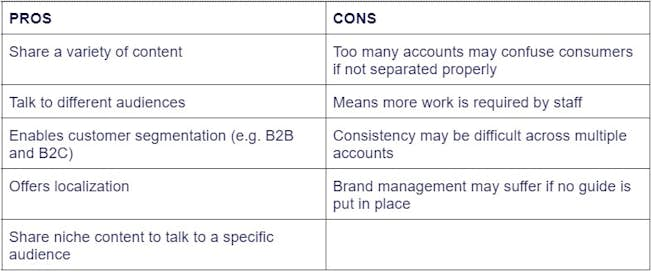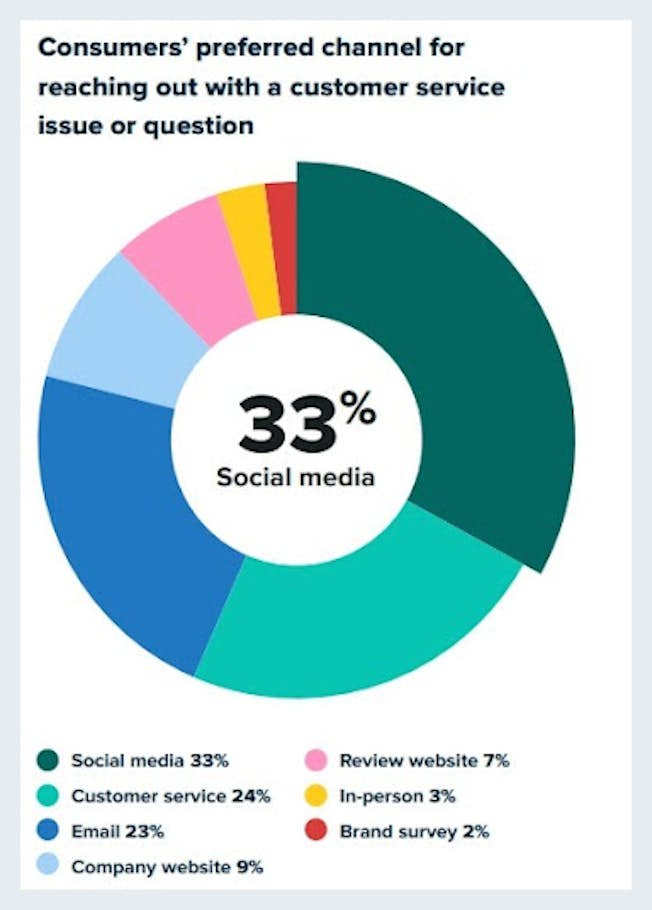Do you find it exhausting managing multiple social media accounts for your business every day? Whether you’re a small business owner or social media manager at a large corporation, you’ll be looking for ideas that will help you get the most out of your social media marketing activities.
It's no secret among social media managers/users that jumping between different tools and accounts can be draining. It's common for social media marketers to manage several accounts for different departments or accounts on different platforms. Some accounts could be dedicated to sales while others are used for customer service.
Despite the energy it sometimes requires, managing multiple accounts on different social networks could be helpful in driving business success. It's all about how you consolidate your efforts and make the most use of the platforms.
Read on to find out how to raise brand awareness, generate leads, and boost sales by effectively managing multiple social media accounts.
Why Should You Have Many Social Media Accounts?
Before we get into the nitty-gritty of social media management, it's important to understand the reasons for and against creating multiple accounts for single brands.
The pros of managing multiple social media accounts
Creating many accounts means you can share a variety of content and talk to different audiences. Customer segmentation allows specific accounts to focus on certain topics as opposed to trying to engage everybody at once. This is particularly helpful if your business serves both consumers and companies.
If your brand has multiple locations across the state or country, having a separate account for each could help you localize content to serve the unique needs of customers in the area. They will feel as though they're being catered to, which can significantly increase engagement.Multiple accounts also give users a choice in the type of content they wish to consume. Even if you have one umbrella account, you may want to branch out with specialty ones. If you wish, all of this content can feed into the main account, but if people find they only want one thing from you, it can be found easily.
The cons of managing multiple social media accounts
On the flip side, owning multiple accounts can confuse your audience. They may not understand the purpose or value of each account. Should they follow all of them or just the ones with the information they need? People might think they will miss something important if your content is posted across different accounts. You also run the risk of dividing up the people you want to reach.
Additionally, having more than one account means more work for Social Media Managers. Time management may become difficult, not to mention staff may also get exhausted. If your social media team doesn't have the resources to run multiple accounts, it's time to reconsider your strategy.
Brand management may also suffer through the use of multiple accounts, especially if different departments are left to run their own social media channels. It's more difficult to ensure everything stays on message if social media duties are spread around.
This is a situation where a social media style guide comes in handy. By using a guide, you can ensure all staff members are on the same page when it comes to social media posting and ensure consistency and best practice. Your guide can cover tone and language but also the use of hashtags, image and video guidelines and audiences. Download our social media style guide and template today to get started!
A Quick Guide to the Pros & Cons
To help you understand the benefits and possible downfalls to managing multiple social media accounts, we’ve created this handy guide.

3 Signs Your Business May Need Multiple Social Media Accounts
If you have multiple accounts or are considering that as a strategy, are you certain it’s the best use of your time and resources? If you’re a single brand, there are a few things to consider.
1. Complaints might occupy most of your feed
More people are using social media to get in touch with companies. According to The Sprout Social Index, Edition XVII: Accelerate, 98 percent of consumers agree that social media is the fastest and most direct way to connect with a brand and is the primary channel for customer service queries.

So if your social media team finds that addressing complaints or managing online customer reviews takes up a lot of time on a general account, it may be beneficial to start a separate account for dealing with support problems. It gives customers an easy channel for complaints and sends a clear message that you care about solving their issues.
Separate accounts for complaints can also function differently if you implement an efficient system for addressing the needs of customers, such as support tickets. Find out how brands are increasingly using social media as a customer service channel to attract and retain customers as many brands adopted WhatsApp messaging for this purpose during the pandemic.
2. You Have Several Departments or Locations
If your business has several departments with different target audiences, it may be worth each one having its own social media account.
Customers can then follow the account, which promotes only products or services that relate to their industry rather than consume everything at once.
The same goes for companies with multiple bureaus or franchises. Separate accounts allow customers to find the information they need much faster. It's okay if these accounts share identical content, but be sure you address the unique needs of customers in your area.
3. You Have Varying Products or Services
Larger companies tend to sell different types of products and services, which address different problems and are relevant to different audiences. If you're known for selling both sports products and technology services, for example, there's likely very little crossover among consumers.
Maintaining social media accounts for different products and services can help avoid confusion and streamline the buying cycle. Everybody knows exactly what they're getting into, and you can cater to the changing needs of separate audiences by creating content that engages.
5 Steps to Managing Multiple Social Media Accounts
Now that you have a good idea of whether or not you need multiple social media accounts, we can finally get into managing them. Here are five steps you can follow to help run each one of your accounts.
1. Document Your Social Media Strategy
If you have a team running multiple accounts, it can be difficult to get everybody to stay on brand. By creating a social media strategy, which includes policies, procedures, and a style guide, you can give users something to follow at all times.
Even if every account has different goals, a documented strategy can help everyone stay in sync and not move away from your company's message.
2. Use Social Media Management Software
It can take too much time to copy and paste the same content to multiple accounts on different social media platforms. The solution? Invest in social media management software such as Buffer that will help you manage publishing and engagement all in one place.
This software can help you post content to different accounts on different networks simultaneously with the click of a button.
3. Create an Editorial Calendar
Editorial calendars are useful for providing direction and making sure you're on track with your social media strategy. This can be done through social media management software or by sharing a simple document with your social team.
It puts everything in one place and provides a reference for Social Media Managers. Also, it can help identify gaps or missed opportunities in your social media posting schedule.
4. Monitor Social Media Activity and Engage
Keeping track of mentions and keywords is important, especially if you set up a support-related account. You want to know if a customer needs help, or if you can jump on a trending topic related to your business.
Most importantly, you don't want to overlap with any of your co-workers. Social media management software should be able to help with monitoring while providing a space for collaboration within your team. It's a bad look if a brand replies either to a year-old post or an inquiry receives two replies.
5. Analyze Your Social Media Strategy
It's important to analyze the results of your social media strategy and measure them against key social media metrics. Are some accounts doing better than others? How can you help ones that are lagging? Does every account contribute to your brand in some way?
You won't know the answers without looking at the platform analytics. Implementing your strategy and using data -driven marketing to read the results to understand what works and fine-tune your approach to social media to deliver optimum results.
Think before you set up multiple accounts
There might be reasons for your company to consider running multiple social media accounts, but before you start creating accounts, make sure you're creating them for the right reasons.
Don't make the mistake of doing it because your competitor has or you think more accounts project the illusion you're a big-time player. Every company has a finite amount of resources, and you should use yours wisely to get the most out of social media.
Through good strategy, intelligent investment and enthusiasm on the part of your social media team, the opportunity for success is always within grasp.
Get in the Social Media Game with a Specialist Course
Know how to set up, populate and manage social media networks such as Facebook, Instagram and YouTube to drive engagement and generate leads. With DMI’s Social Media Marketing course you will understand how to research, strategize and provide a customer service channel that can help your business stand out from the crowd.
- Categories:
- Articles
- Social Media Marketing
Upgrade to Power Membership to continue
your access to thousands of articles, toolkits, podcasts, lessons and much much more.
Become a Power Member- Login
- View Courses
- - - -
- Courses
- Resources
- - - -
- My Account
- Change Password
- Logout




